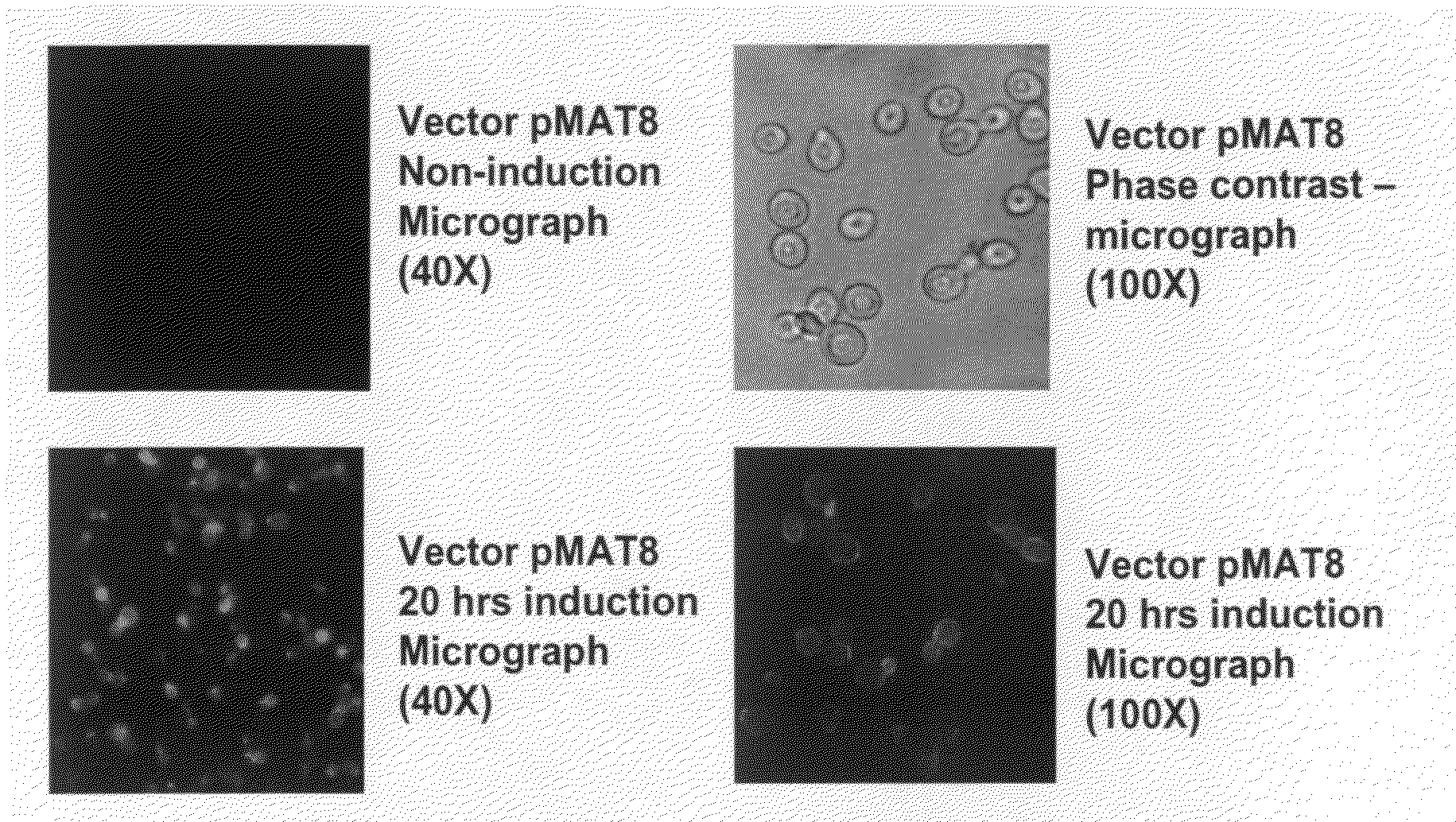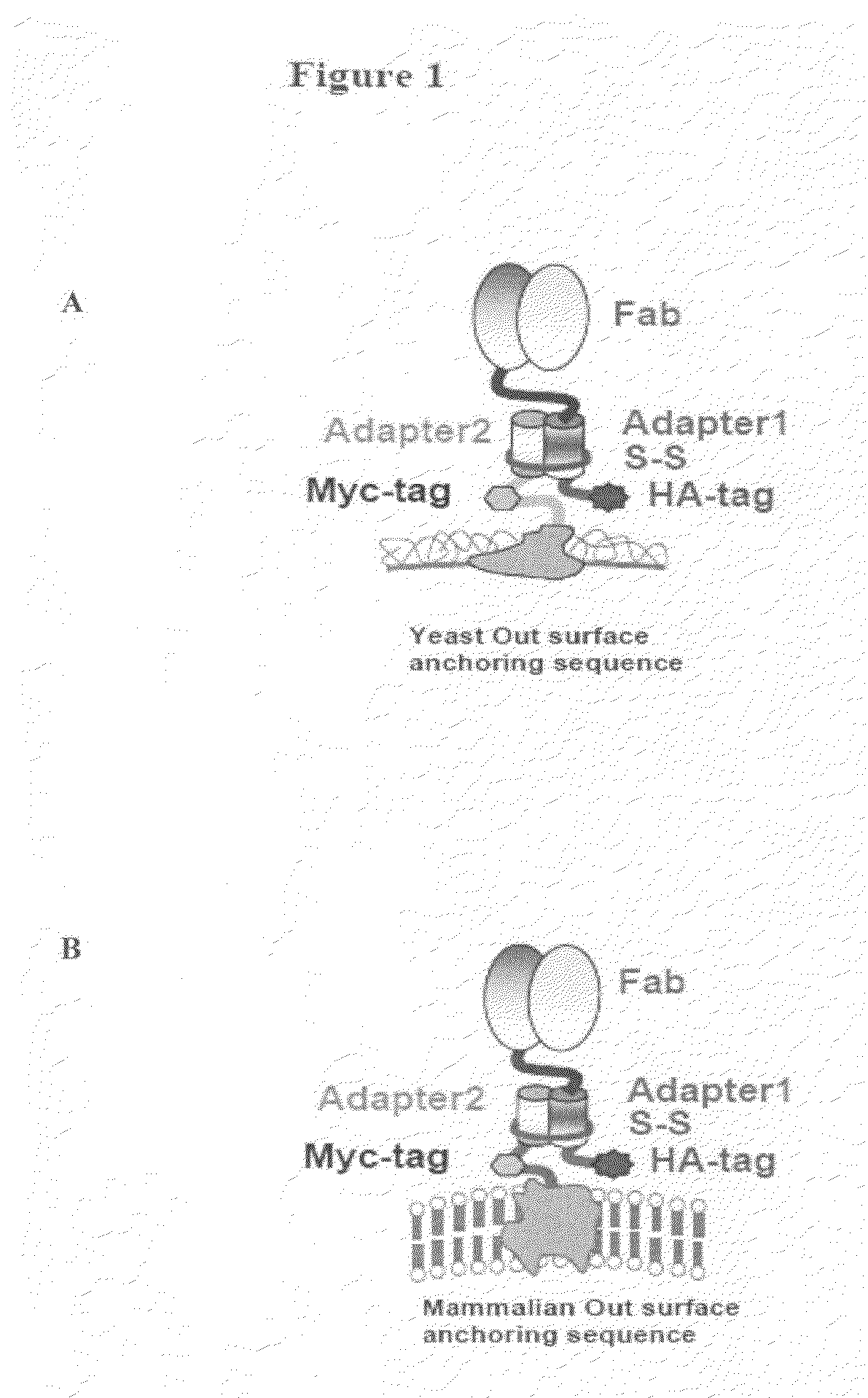Eukaryotic cell display systems
a cell display and eukaryotic technology, applied in combinational chemistry, dna preparation, library creation, etc., can solve the problems that prokaryotic host cells are typically not able to accomplish the full range of post-translational modifications, and eukaryotic proteins cannot be functionally expressed in prokaryotic cells, so as to facilitate the direct expression of library proteins
- Summary
- Abstract
- Description
- Claims
- Application Information
AI Technical Summary
Benefits of technology
Problems solved by technology
Method used
Image
Examples
example 1
Construction Yeast Expression Vector pMAT9
[0109]pMAT9 vector (FIG. 2A) comprise a expression cassette for an anti-VEGF scFv antibody fused with adapter1 (GR1) (SEQ ID NO:1) and detectable HA and His6 tag (DH tag). It was constructed by insertion of a fully synthetic gene fragment into a commercial pESC-TRP vector (Stratagene) through cloning sites EcoRI and PacI. The scFv-GR1 fusion protein is under the control of a galactose-induced promoter GAL10 and a signal sequence of yeast endo-beta-1,3-glucanase (Bgl2). The fusion gene sequence (SEQ ID NO:3) was confirmed by standard DNA sequencing method.
example 2
Construction Yeast Expression Vector pMAT12
[0110]pMAT12 (SEQ ID NO: 4) provides an expression vectors that is suitable for expression in yeast cells. As shown in FIG. 2B, pMAT12 is created on the backbone of commercial vector pUC19 by insertion at Aatll and Pcil sites with a fully synthetic DNA fragment (Codon Devices). This fully synthetic DNA fragment comprises (1) fl ori; (2) a expression cassette for the adapter GR1 (SEQ ID NO:1) fusion, which is driven by a yeast pGAL1 promoter. The sequence of anti-VEGF scFv antibody is built in the downstream of a yeast signal sequence (yeast endo-B-1,3-glucanase protein Bgl2p). The HA-His6 tag (DH-tag) sequences are upstream of GR1 sequence for protein detection and Ni-NTA purification. (3) yeast CEN / ARS ori for replication; and (4) a expression cassette for yeast TRP1 auxotrophic marker. The synthetic DNA sequence was confirmed by standard DNA sequencing method.
example 3
Yeast Helper Vector pMAT7
[0111]pMAT7, which is graphically depicted in FIG. 3A, is another yeast display helper vector which expresses a fusion protein comprising the yeast outer surface protein Aga2 in frame with adapter 2 (GR2) (SEQ ID NO: 2). This vector was created from the yeast helper vector pMAT3 by replacing BamHI-HindIII fragment with a synthetic DNA fragment of 208 bp. This synthetic DNA comprises the sequence encoding yeast out well protein Aga2. Using BioFab platform technology of Codon Devices, the errors generated from oligo synthesis were corrected by oligo selection with sequences complementary to the synthetic genes, and affinity purification of Mut-S protein column. The nucleotide sequence of pMAT7 (SEQ ID NO: 5) was confirmed by standard DNA sequencing.
PUM
| Property | Measurement | Unit |
|---|---|---|
| surface anchoring | aaaaa | aaaaa |
| soluble | aaaaa | aaaaa |
| densities | aaaaa | aaaaa |
Abstract
Description
Claims
Application Information
 Login to View More
Login to View More - R&D
- Intellectual Property
- Life Sciences
- Materials
- Tech Scout
- Unparalleled Data Quality
- Higher Quality Content
- 60% Fewer Hallucinations
Browse by: Latest US Patents, China's latest patents, Technical Efficacy Thesaurus, Application Domain, Technology Topic, Popular Technical Reports.
© 2025 PatSnap. All rights reserved.Legal|Privacy policy|Modern Slavery Act Transparency Statement|Sitemap|About US| Contact US: help@patsnap.com



